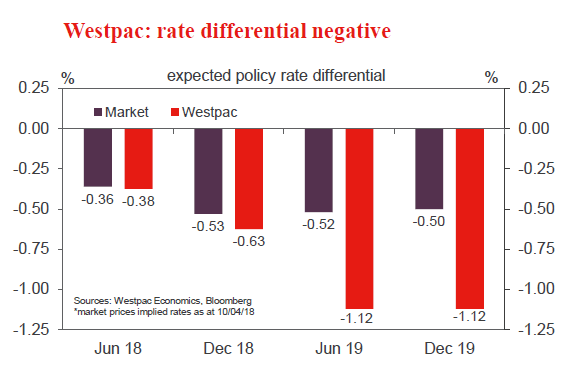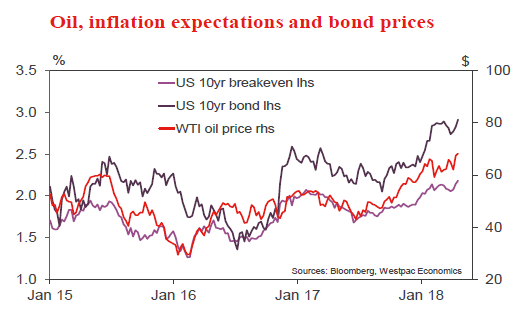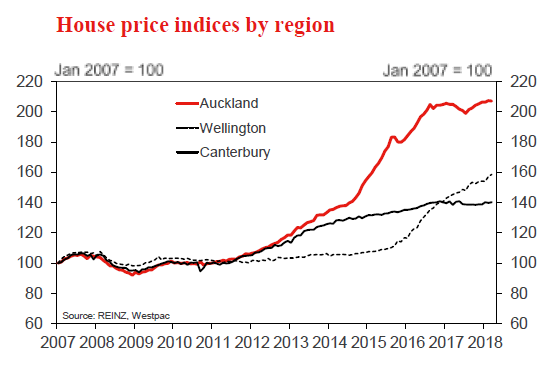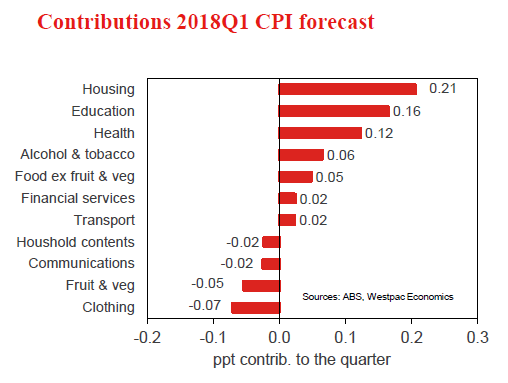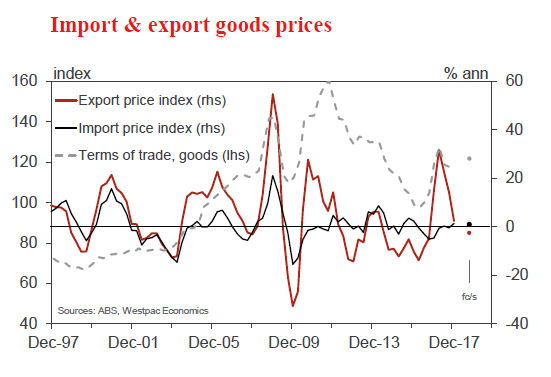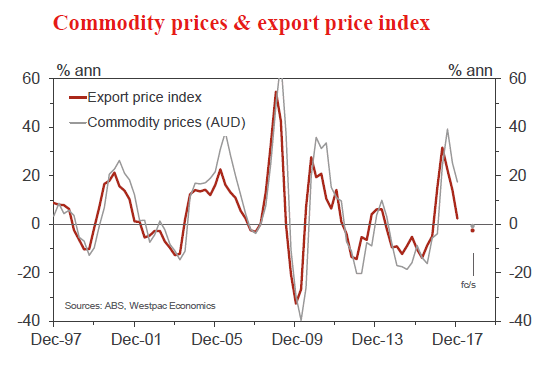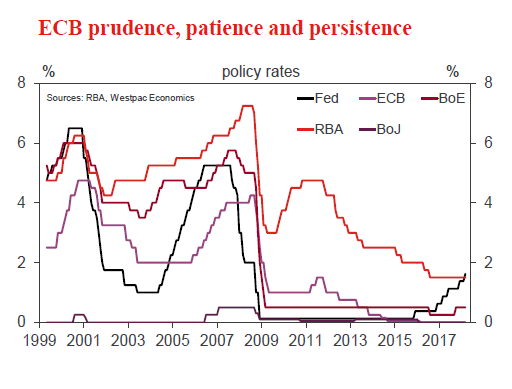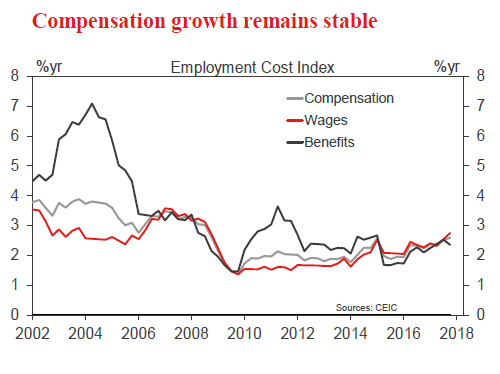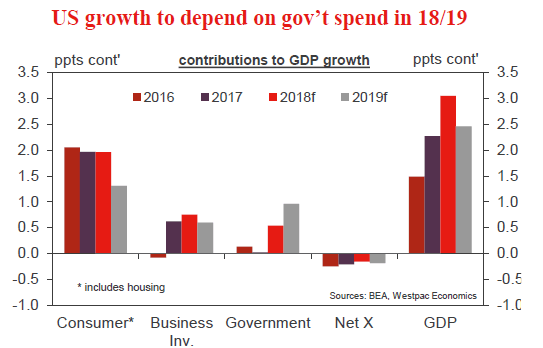Week beginning 23 April 2018
- Inflation risks; financial conditions; and jobs all raise risks for RBA’s outlook.
- Australia: CPI, trade prices, RBA Assistant Governor Kent speaks, ANZAC day.
- NZ: trade balance, net migration.
- China: industrial profits.
- Euro Area: ECB policy decision.
- US: GDP, employment cost index.
- Flash PMIs.
- Key economic & financial forecasts.
Information contained in this report current as at 20 April 2018.
Inflation Risks; Financial Conditions and Jobs All Raise Risks for RBA’s Outlook
The minutes of the Reserve Bank’s Board meeting on April 3 contained a surprise in the final paragraph – “it was more likely that the next move in the cash rate would be up, rather than down”.
We have seen the Governor make that statement in speeches but have not previously seen a formal confirmation from the Board.
The timing is particularly pertinent given developments around financial conditions; the jobs market; and a looming Inflation Report.
Think back to April 2016. Markets were relatively benign with one cut priced in over the next 12 months. Today markets are priced for one hike by mid-2019.
Then we saw the March 2016 Inflation Report. Markets were expecting a rise of 0.5% in the underlying inflation measures while our analysis of the RBA’s forecasts suggests it was expecting 0.6%.
In the event the underlying CPI measures printed an average of 0.175%. The Board had been forecasting 2.5% for annual underlying inflation for 2016. On the basis of that March Report the forecast was lowered to 1.5% and the Bank cut the cash rate by 0.25% in both May and August 2016.
On April 24 there will be another Inflation Report, this time for the March quarter 2018. Westpac (and the market) is once again forecasting 0.5% for the average of the underlying measures. This time, however, the Bank is forecasting 1.75% for 2018 implying an average of around 0.45% for each quarter.
What caused the big surprise in 2016?
“House purchase” (the cost of building a home) rose by only 0.2% whereas we expect 0.7% (following 0.6% last quarter) for March 2018.
Most of the demand related components were lower in 2016 than we expect in 2018.
Clothing and footwear (-2.6% in 2016; -2.0% in 2018); household contents (-0.4%; -0.3%); communication (-1.5%; -0.9%); audio visual (-3.5%;-2.2%); holiday travel (-2.0%; -0.2%) are all expected to be less negative in 2018 than 2016 but nevertheless signalling deflationary forces.
We also expect the large seasonal components pharmaceuticals (4.8% in 2016; 5.3% in 2018) and education (3.1% in 2016; 3.8% in 2018), to be higher in 2018.
Finally there was a 10% fall in fuel prices in 2016 whereas they have been steady in 2018. This component would have been “trimmed out” of the 2016 numbers although there would have been some indirect effects through business costs that may have further biased down the 2016 numbers.
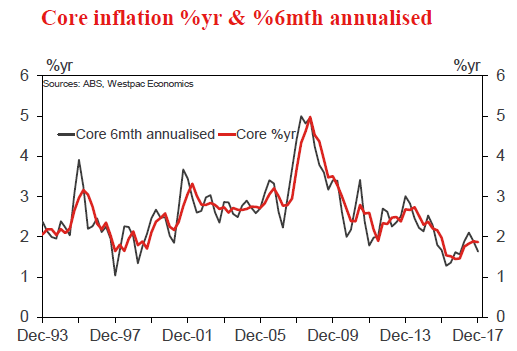 So we can reasonably conclude that the housing weakness and strong deflationary effects we saw in 2016 are unlikely to be replicated in the same size in 2018 dismissing the prospects of a 2016 style shock. Nevertheless the themes remain the same – weakening housing and deflation in demand related components precluding us from entirely dismissing a repeat of the 2016 episode.
So we can reasonably conclude that the housing weakness and strong deflationary effects we saw in 2016 are unlikely to be replicated in the same size in 2018 dismissing the prospects of a 2016 style shock. Nevertheless the themes remain the same – weakening housing and deflation in demand related components precluding us from entirely dismissing a repeat of the 2016 episode.
Further, I don’t expect that Governor Lowe would respond to such a shock in the way we saw with Governor Stevens. True, both were or are observing a rapidly cooling housing market.
In March 2016 Sydney house prices had fallen 4.2% (six month annualised) compared with an increase of 18% a year earlier. In Melbourne prices were up by 2.8% compared to 21% a year earlier.
Today the numbers are Sydney (-5.4%; 21%) and Melbourne (2%; 16%). Note the second boom in house prices in both Sydney (21%) and Melbourne (16%) followed the 2016 rate cuts.
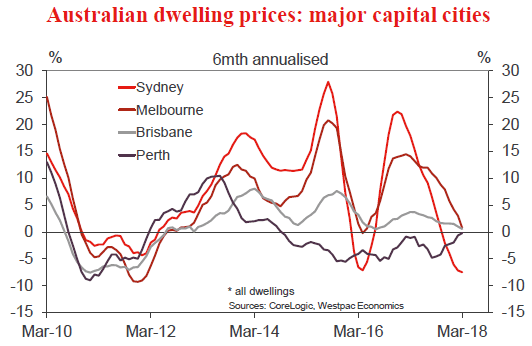 Governor Lowe has the benefit of observing that the Stevens’ rate cuts achieved little in restoring inflation pressures (note we are still experiencing deflationary pressures in the demand related components of the CPI) while the cuts did reignite the housing market requiring another round of macroprudential policies.
Governor Lowe has the benefit of observing that the Stevens’ rate cuts achieved little in restoring inflation pressures (note we are still experiencing deflationary pressures in the demand related components of the CPI) while the cuts did reignite the housing market requiring another round of macroprudential policies.
However Governor Lowe is now facing a significant tightening in financial conditions, partly emanating from offshore, that was not apparent for Governor Stevens.
The Bank Bill Swap Rate which determines funding costs for most corporates and commercial borrowers has lifted by around 30 basis points – spreads against the risk free rate are now the widest since 2009.
This rate also drives the wholesale funding costs of banks and non-banks.
Various explanations have been put forward to explain this development. It appears to be the unfortunate coincidence of a number of factors which are impacting both the demand and supply of US money market instruments. On the supply side the US Treasury has sharply lifted its issuance of short term assets to fund the lifting of the debt ceiling and the fiscal stimulus.
On the demand side we have seen the US Federal Reserve begin to shrink its balance sheet after years of quantitative easing while US corporates who had accumulated vast quantities of short term paper investments are now eschewing those investments in favour of very short term liquidity in anticipation of managements’ decisions on the use of this liquidity. This flexibility comes in response to tax changes announced in the recent overhaul of tax arrangements which has freed up these liquid investments. In addition, the BEAT tax has encouraged US branches of foreign banks to replace inter-office loans with direct wholesale funding.
These forces have boosted the LIBOR rate which has fed directly into the BBSW rate as Australian banks convert more expensive US funding to AUD or switch demand back to the domestic markets.
While conditions for business borrowers have tightened, banks have not adjusted their standard variable mortgage rates therefore moderating the impact on the economy of these higher rates.
However, banks must be experiencing some pressure. This would be despite the fact that banks have raised their retail deposit shares of funding from around 50% pre GFC to around 60%.
At least one mortgage lender has raised its mortgage rates (another bank Suncorp raised rates by 5bps). Members Equity Bank has raised its owner occupier principal & interest (P&I) rates by 6 bps; Investor P&I by 11 bps; and investor interest-only loans by 16 bps. This entity would not have the extensive access to retail deposits that we see for the banks and would therefore most likely be disproportionately affected by the increase in wholesale rates. ME Bank also attributed the rate hike to increased compliance costs associated with the regulator.
These policy moves from the regulator can also be expected to tighten financial conditions over the medium term. The Reserve Bank’s Financial Stability Review notes that, according to their estimates, directions to move borrowers from interest only loans to principle and interest may have implications for households’ disposable incomes. Around 30% of the current stock of mortgage credit is expected to move from IO to P&I over the next 4 years. The step up in mortgage payments when the IO period ends is estimated to be in the range of 30 to 40 per cent even after factoring in the typically lower interest rates charged on P&I loans.
This constant pressure on the household balance sheet can, arguably, lower the “neutral” interest rate over that period. Currently the Reserve Bank estimates it as a cash rate of 3.5%.
Finally it would be remiss not to point out further confirmation of our view that the growth pace of the labour market would ease significantly in 2018. Recall that employment growth over 2017 has been around 3.4% while the momentum in the first three months of 2018 has slowed to 1.2%. We remain comfortable with an expectation of around 2% employment growth in 2018 – a pace likely to hold the unemployment steady around 5.5%.
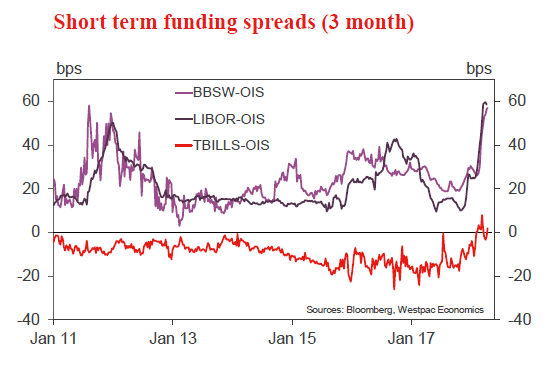 In conclusion we do not see the decision by the Board to speculate that rates have bottomed out as significant. The basic trends in inflation remain in place along the lines of what we saw in 2016. In such an environment there will always be a chance of a much lower Inflation Report on April 24 than we are expecting (recall 2016). However, until recently, the hurdle for lower rates has been much higher than 2016.
In conclusion we do not see the decision by the Board to speculate that rates have bottomed out as significant. The basic trends in inflation remain in place along the lines of what we saw in 2016. In such an environment there will always be a chance of a much lower Inflation Report on April 24 than we are expecting (recall 2016). However, until recently, the hurdle for lower rates has been much higher than 2016.
In 2016, we did not experience this bout of tightening financial conditions either through rising funding costs or regulation. Combine that with a slowing housing and jobs markets and if anything, the Board’s declaration does look a little bold.
Westpac remains very comfortable with its out of market call for the cash rate to remain on hold in 2018 and 2019.
The week that was
Market sentiment held up on earnings beats as we took a breather from lingering geopolitical tensions but the continued rally in commodities saw inflation expectations and yields higher. Domestically, the disappointing labour force report was the major update with the RBA minutes holding a stable stance ahead of the May Statement on Monetary Policy.
Australian employment rose by 4.9k in March and past employment results were also revised due to ABS annual seasonal re-analysis. Notably, February’s result was revised down to -6.3k from +17.5k and thus ended sixteen consecutive months of job gains. That adds further evidence that momentum has come out of employment growth. The unemployment rate printed at 5.5% with progress on reducing slack having correspondingly stalled. Rising participation had accompanied the jobs boom in 2017 but that too eased back in line with the weaker jobs numbers over February and March. Overall, the stellar pace of jobs growth seen in 2017 was not sustainable, and while 2018 has begun on a slower footing, positive business conditions and economic activity still point to a year of decent jobs growth.
The RBA minutes contained few surprises. Arguably of most interest was the first sentence of the final paragraph, “in current circumstances, members agreed that it was more likely that the next move in the cash rate would be up rather than down”. Though this observation is new to the minutes, the line had been repeated by the Governor on numerous occasions in his own speeches and reflects the expectation of “gradual” progress on unemployment and inflation as well as the higher barrier to cutting rates due to financial stability risks. On the latter though, the RBA appears more relaxed as concerns over household leverage are no longer building with lending standards improved post macroprudential reform.
On the labour market, the commentary already appeared a little more reserved even though the Board had not yet seen the March data update at the time of the meeting. Further hints of lowering the 2018 growth forecast were also made clear as growth “was expected to exceed potential”, maintaining the distance from their “a little above 3 per cent” communication in February. Potential has been assessed in the past at 2¾ per cent and this compares to their February 2018 growth forecast of 3¼ per cent. We will find out their updated estimate in the May 4 Statement on Monetary Policy.
Turning to international releases, Q1 GDP in China was steady at a 6.8% year on year growth rate. In March, services output accelerated but was offset by slowing investment and industrial production. That dynamic is consistent with the authorities’ goal of transitioning China to a consumption driven economy. The authorities’ national growth target is unchanged at around 6.5% for 2018 and we expect the Chinese economy to slow over the year. In relation, this week also saw the PBOC cut the required reserve rate by 1ppt for large commercial banks and some other lenders. This coincides with the tightening in policy of the shadow banking sector and subsequent need for the official banking sector to make up for the loss in credit momentum and support economic growth.
In the US, the week begun with President Trump’s announcement of two new candidates for the Federal Reserve Board of Governors. For Vice Chairman, he put forward Dr. Richard Clarida, PIMCO Chief Economist and Professor at Columbia University. From the New-Keynesian line of thought, the appointment of Clarida represents continuity in the Fed’s thinking – his recent paper on global neutral rates is worth a read. Trump also selected Michelle Bowman to join the board in a position focused on community banking regulation. She is the current Kansas Bank Commissioner and a former community bank executive.
In terms of data, the retail sales release for March surprised on the upside at 0.6% vs. expectations for a 0.4% gain. The positive retail sales results follows three consecutive negative prints and still suggests consumption will be slower in Q1 GDP than Q4’s wellabove average pace. Providing some offset though is likely to be inventories, as this week also saw business inventories print at 0.6% in March, while industrial production too posted a solid 0.5% gain.
Elsewhere in the world, we saw the Bank of Canada hold rates and emphasise a cautious approach to their current tightening bias. Data has been softer in the first part of 2018 with employment slowing and growth lower, but on the other hand, core inflation has picked up to the 2% target mid-point. In the UK, both the CPI and retail sales undershot expectations and takes the pressure off the BOE’s (albeit still live) May 10 meeting.
Finally on the trade dispute, this week’s announcements were taken in stride by the market. Trump u-turned on his shortlived optimism around TPP and called out Russia and China for currency devaluation. China announced a 179% deposit for importers of US sorghum and US TIC flows data showed that they increased their holdings of US government debt to the highest level in six months. Not too long ago, that would have been a chaotic week in trade news, but in today’s context it is a welcome pause for breath as we switch our minds to next week’s Australian CPI release.
Chart of the week: Oil sees yields higher
The WTI oil price tested the $70 price level on Thursday before closing at $68. OPEC met on Thursday and confirmed that oil inventories in developed economies had dropped to 12 million barrels over the official target of the five year average. That compares to the extra 340 million barrels at the beginning of 2017.
The rise in the oil price has flowed through to market inflation expectations. On Wednesday, US 10yr breakevens broke through February’s 2.15% high associated with the jump in the average hourly wages print and has since extended further to 2.18%. The current breakeven rate is around levels seen in 2014, prior to the collapse in oil prices.
Consequently, US 10yr bond yields have risen, closing at 2.92% on Thursday, just below February’s high of 2.95% and in sight of the key 3% level.
New Zealand: week ahead & data wrap
Consumer prices rose by 0.5% for the March quarter, which was in line with our forecast but a touch below the Reserve Bank’s estimate of a 0.6% rise. The quarterly result was by no means a weak one – in fact it was one of the stronger quarterly outturns in recent times. And that was even after the impact of the new Government policy of a year’s free tertiary study, which knocked 0.14% off the inflation rate.
Tradables inflation remains weak, with prices in import-heavy categories such as clothing, furnishing and electronics all softer than we expected. That highlights the lack of inflation pressures among our trading partners, as well as the ongoing squeeze on New Zealand retailers’ margins. The New Zealand dollar hasn’t given much of an assist to import prices in recent times, with only a slight fall in the exchange rate over the last year.
In contrast, the more persistent non-tradables components were a little stronger than we expected (and quite a bit higher than the RBNZ’s forecast). Non-tradables inflation has picked up a bit from its lows in the last couple of years, in keeping with an economy that is running closer to full capacity. However, it remains well below the levels we saw in the years before the financial crisis.
Annual inflation has dropped towards the lower end of the RBNZ’s target range, but this move is likely to be temporary. It’s partly a matter of timing – prices rose sharply in the March quarter last year, but then were very soft through the middle part of the year. As those past readings drop out of the calculation, the year-on-year comparison will become more favourable for the RBNZ over the rest of this year.
We’re also expecting a bit of a boost to tradables inflation in coming quarters. The lower New Zealand dollar should give a boost to retail prices (or limit price declines) with its usual lagged impact. In addition, planned increases in fuel taxes will add to the inflation rate in the second half of this year.
However, a sustained lift to the 2% mid-point of the RBNZ’s target is a more daunting task. Weak tradables inflation is a global trend, and the boost to import prices that we expect from a lower NZD won’t persist into next year. If imported price pressures are missing in action, then home-grown inflation will have to pick up a lot more than it has to date. But there are a number of headwinds to such a move as well.
There was one aspect of the March quarter CPI that particularly highlighted the difficulty of getting inflation higher. The housingrelated components of the index, such as rents, newly-built homes and realtor services, are among the few that have consistently added to overall inflation in recent years. But these components have slowed as the housing market has cooled, and were notably subdued in the March quarter.
Rents rose by 0.6%, with a slowdown in Auckland offsetting a pickup elsewhere. Meanwhile, new home prices rose just 0.4%, the smallest quarterly rise in more than six years. This highlights that the upward pressure on building costs in recent years has not just been a product of capacity constraints; builders have more scope to raise their prices when existing home prices are running hot. The housing market has regained some momentum after a slowdown in the first half of last year. Auckland house prices have recovered all of their decline, and prices have continued to rise in much of the rest of the country. (Canterbury is the main exception, as the housing stock has been restored to preearthquake levels.) An easing in lending conditions – both lower mortgage rates and a loosening of loan-to-value restrictions – have helped to lift housing demand in recent months.
But there is an array of new Government policies lined up against the housing market, including:
- An extension of the ‘bright line’ test. In 2015 a new rule required people to pay tax on capital gains if they resold an investment property within two years. This has now been extended to five years, a significant holding period for investors.
- A ban on foreign buyers of residential property, probably from the middle of this year.
- The phasing out of ‘negative gearing’ – the ability of property investors to use losses from rental properties to reduce their overall tax bill – from next year. This will reduce (but not eliminate) the tax advantage that investors have over firsthome buyers and over other forms of investment.
- A reduction in net migration.
- The likelihood that the Tax Working Group will recommend a capital gains tax excluding the family home. This would not be introduced until the Government’s next term.
On top of these policy moves, we think that mortgage rates are more likely to rise than fall in the coming years, in an environment of rising global interest rates. All together, we are forecasting a small decline in house prices in the second half of this year, and for prices to remain subdued in the following years. In those circumstances, it is hard to see the housing components of the CPI as a greater source of inflation than they already have been to date.
Data Previews
Aus Q1 CPI
Apr 24, Last: 0.6%, WBC f/c: 0.5%
Mkt f/c: 0.5%, Range: 0.3% to 0.9%
- Westpac’s forecast for the headline CPI is 0.5%qtr holding the annual pace flat at 1.9%yr. Core inflation is also forecast to print 0.5%qtr (0.50% at two decimal places) holding the annual pace flat at 1.9%yr.
- In the March quarter the increasing perseverance of post- Christmas sales now overwhelms an historical seasonal uplift associated with the re-pricing of administrated prices and the resetting of the Pharmaceutical Benefits Scheme. The ABS estimates a seasonal factor of slightly more than -0.1ppt.
- Core inflation remains below the bottom of the RBA target band and with the expected moderation in dwelling purchases price inflation through 2018, along with consumer goods still captive to a competitive deflationary cycle, it is hard to see core inflation breaking much higher.
Apr 26, Last: 2.0%, WBC f/c: 0.8%
Mkt f/c: 1.2%, Range: 0.0% to 3.0%
- Prices for imported goods increased by 2.0% in the December quarter impacted by the lower currency in the period. Over the 2017 year, import prices lifted by a modest 1.4%, boosted by higher global energy prices.
- For the March quarter of 2018, we expect a 0.8% rise in import prices, with the annual change moderating to 1.0%. • The currency slipped in the quarter on a TWI basis, declining by 0.7% to 64.2, some 2.7% below the level of a year ago.
- In addition, the bill for fuel imports rose in Q1 as global energy prices increased a little further in the period.
Apr 26, Last: 2.8%, WBC f/c: 3.7%
Mkt f/c: 4.1%, Range: 2.5% to 5.0%
- Export prices moved higher late in 2017, +2.8% in Q4, after a mid-year slump, -5.7% in Q2 and -3.0% in Q3. For the 2017 year as a whole, export prices rose by 2.4% to be 24% above the low at the start of 2016, reflecting the rebound in commodity prices, up from historic lows.
- For the March quarter, export prices are expected to increase by 3.7% supported by higher commodity prices in the period. Despite this, export prices would still be 2.5% below the level of a year ago.
- The terms of trade for goods, on these estimates, increased by almost 3% in the March quarter. That still leaves the index 4.5% below the level of a year ago.
- As to prices for services, an update will be available with the release of the Balance of Payments on June 5.
Apr 26, last -0.40%, WBC -0.40%
- Increasingly, it is becoming evident that Euro Area growth is past its peak. The outlook for the ECB will depend heavily on the pace of slowing seen across the region. If inflation is to move towards trend, then above-trend growth must persist throughout the forecast period.
- While not anticipating a collapse in growth by any means, we continue to believe that remaining slack in the Euro Area combined with a softening growth pace (from 1.25ppts above trend in 2017 to closer to 0.25ppts in 2019). To our mind, this will not be enough to drive inflation to target, but will see it move closer than it has been.
- The consequence of the above outturn should be a slow end to asset purchases, extended to December, followed by an unwinding of negative interest rates in H1 2019, and an eventual rise in the refinance rate, in Q4 2019. In the near term, the tone of language will be all that changes.
Apr 27, last 0.6%, WBC 0.7%
- Emerging across all wage and compensation measures for the US economy is a slow but sustained uptrend. Over the past year, annual growth in the employment cost indexes’ total compensation measure has accelerated from 2.2%yr to 2.6%yr, the result of stronger wages and benefits for most workers in both the public and private sector.
- Come Q1 2018, while the annual growth pace will slow a touch to 2.5% owing to a base effect, we anticipate that the quarterly growth pace will accelerate (from 2.4% annualised to 2.8%). This uptrend will persist through 2018, though progress will remain slow.
- Worth keeping an eye on are the spread of conditions across private industries and the public sector. Conditions are likely to remain variable, limiting the benefit of higher wages and conditions to some.
Apr 27, last 2.9%, WBC 2.8%
- The detail of the Q4 GDP outcome was much stronger than the headline reading made out. This was true of the first estimate of 2.6% annualised as it was the third at 2.9%. In comparison, Q4 domestic final demand growth came in at 4.8% annualised, driven higher by strength across household consumption; residential investment; and business investment as well as an uplift in government spending.
- Come Q1 2018, a similar outcome is expected, circa 2.8%. However, the make-up of growth will be quite different. Retail and PCE data point to a soft consumer; and business investment has struggled to move higher. It is also likely too early for the government to add materially to growth. The component that is like to fill the gap is inventories which have exhibited strength of late. Domestic final demand is therefore likely to come in at 2.3% annualised – or lower.




